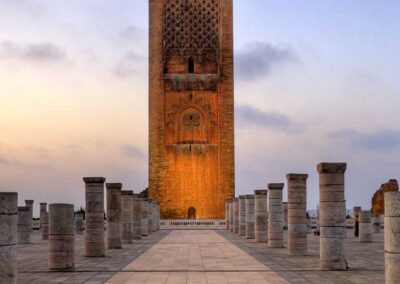5 Days Morocco Tour from Rabat
Overview
A good mix of modern and historical cities can be found in northern Morocco on this 5 days Morocco Tour from Rabat itinerary. Begin and end in the Capital city of Rabat, then travel to Chefchaouen, also known as “the blue city,” located in the Rif Mountains. Proceed south to the Roman ruins at Volubilis, Meknes, and immerse yourself in medieval Fes, the cultural center of the world.
Highlights:
- Visit Hassan Tower in Rabat
- Bab Challah and Oudaya Kasbah
- Hassan2 Mosque in Casablanca
- Discover the panoramic city of Chefchaouen
- Travel through the Riff Mountains
- Ruined Berber-Roman town- Volubilis
- There are many beloved places in Meknes
- Visit the Medieval city of Fes
- Qaraouine University to take a look
Day 1: RABAT
The pickup and transportation from the airport to your lodging in Rabat marks the beginning of the 6-day tour from Rabat. After you have settled in, we will take you to see the Royal Palace, which is a large parade ground located at the end of the Mechouar. The official residence of the King of Morocco is this palace, which dates back to 1864. There will also be visits to the Mohamed V Mausoleum, Hassan Tower, Challah Gardens, and the fortified Oudaya Kasbah. We will have dinner at your hotel in Rabat. Accommodation/Riad choice: Riad Zyo Rabat / or Corresponding Meals: Breakfast
Day 2: The Blue City of Chefchaouen
See the picturesque Chefchaouen in the Rif Mountains this morning by traveling even further north. Enjoy the beautiful scenery as you travel through green hills and flat plains that give way to a mountainous terrain. Known for its blue-washed buildings in its historic medina, Chefchaouen, which has remained mostly unaltered since the 15th century, offers a laid-back vibe with some of the friendliest locals in the nation. Take a stroll along the northern hillside’s winding streets and narrow alleys. See the main square, Plaza Outa el-Hammam, and then stop by one of the eateries or cafés around it for a bite to eat.
If you are feeling particularly active, climb the hill to the city walls and then take the path that leads to Hotel Atlas. Climb up to the rooftop and take in the breathtaking panorama of Blue City. When the day is almost over, make sure to head east on the streets and hike up the hill for 20 to 30 minutes to reach the white Spanish Mosque. This 1920s-era building, which has never been occupied, is in a prime location for watching the sunset behind the mountains.
Day 3: Roman ruins at Volubilis and imperial cities of Meknes and Fes
Photographers who love taking pictures of deserted and charming streets will love getting out of bed early. After leaving Chefchaouen, get back in the car with your driver and proceed toward Fes. Stop along the route and extend your legs to explore the Volubilis Roman Ruins, which are protected by UNESCO. Almost a millennium after it was founded in the third century BCE, the sprawling complex that has been partially excavated was abandoned. It used to be one of the most isolated regions of the Roman Empire and was a flourishing city in its day. You can also go to the smaller, less crowded Meknes from here, which is a good way to get ready for your stay in Fes. The Imperial City, or Ville Imperial, and the easily navigable medina are Meknes’ two primary points of interest.
Travel towards the east to Fes and lose yourself in the remarkably expansive and intricate ancient medina that cascades down a hillside. Starting at the Marinid Tombs above the city, you can enjoy an overview of the old city and get a sense of where you are to fully appreciate the size of Fes. It is best to visit the tombs at dusk when the calls to prayer from the muezzin echo throughout the valley and the city lights begin to come on. Get comfortable in your traditional Riad.
Day 4: Exploring the Medieval Medina of Fes
Fes is the oldest of the four imperial cities and is regarded as having the most complete medina in the Arab world. It is also a UNESCO World Heritage site. Fes’s motley streets give you an idea of what it was like to live in medieval Morocco, as the city has remained mostly unaltered since its founding more than a millennium ago. It consists of three parts: the more contemporary Ville Nouvelle, which was influenced by French colonialism, and the two-medina quarters, Fes el Bali and Fes el Jdid. It is frequently referred to as the cultural capital of the nation. Meet your guide for a half-day tour, during which you will explore the medinas’ winding, narrow streets and discover the rich history and culture.
Commence at the well-known Bab Boujeloud gate in Fes el Bali (789 CE) and proceed into Talâa Kebira’s main thoroughfare. As you stroll through stores and souks (markets), looking through local merchandise for presents and mementos, take note of the architecture with influences from Spain and Tunisia. Marvel at the plethora of dye-filled stone pots at the Chouara Tannery, which dates back to the eleventh century. The men at work employ old methods that have been around for hundreds of years. After that, pay homage to the elaborate zellij tile work of the 14th-century Al Attarine Madrasa before moving on to Fes el Jdid, the 13th-century “new city.” Take in the expansive views of the city when you visit the Mellah, the historic Jewish neighborhood and cemetery. Explore the striking architectural transformation by going to Ville Nouvelle, if you have the time.
Day 5: Return to Rabat
You have free time in the morning. Take a tour of a Ceramics and Tile Collective to discover the process of how regional craftspeople create their goods, from molding clay to applying paint. Additionally, you can watch the master tile installers as they piece together tiny tiles to create intricate mosaics.
Travel towards Rabat.
what's included
- Private A/C Vehicle, 4WD Toyota Land Cruiser or Minibus for the selected tour + fuel
- English-speaking driver during the tour
- Pick up and drop off at your Marrakech accommodation
- rooms with A/C in typical hotels, Kasbahs & Riads with dinner and breakfast (Vegetarians are welcome)
what's excluded
1. Lunch between 5-15 euro
2. Beverages
3. Optional activities
4. Personal expenses









